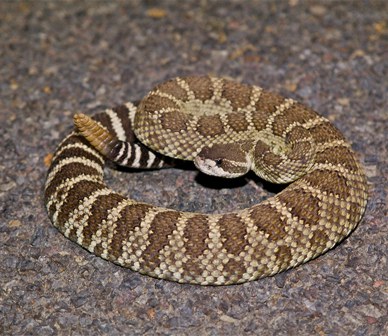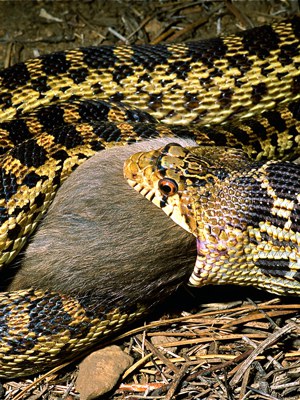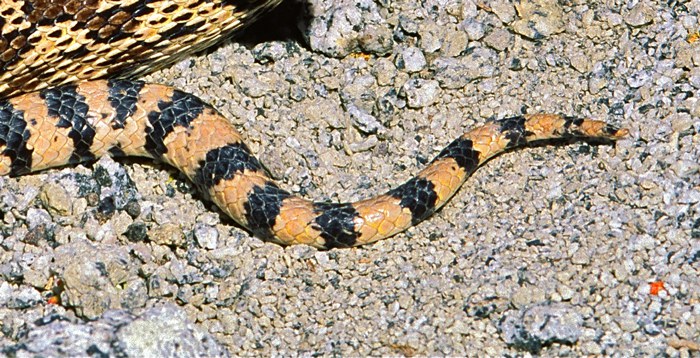
“There’s a rattlesnake on my patio, and I’m afraid to go out there or let my little dog loose in the yard! It’s just too dangerous. The Oregon Department of Fish Wildlife office told me you could help with my predicament.”
Being a reptile specialist, I’d dealt with calls like this before and sympathized with her obvious terror. So after obtaining directions, within minutes I parked my car in front of her home at the edge of town. As she’d instructed, I followed a path that led rearward to the patio, where I saw her anxiously peering out a tightly closed sliding glass door, an arm-cradled poodle loudly barking. After spotting the coiled snake, I watched her facial expression shift to total surprise when I merely reached down and picked up the reptile, allowing it to freely slither around in my hands.
What was mistakenly thought to be a venomous rattler was actually a harmless gopher snake (Pituophis catenifer). If she’d been equipped with a bit of rudimentary knowledge for differentiating the two species, needless stress could have been avoided.
Interestingly, not all gopher snakes react in this melodramatic manner. Temperament varies, and when some individuals are initially handled in the wild they don’t struggle, hiss, or bite. More often than not, however, a gopher snake will masquerade as a vicious viper when you approach it.
When boot rubber meets the trail, though, and you’re confronted with a blotched snake slithering across the path, what to do? How can you know if it’s merely a blustering gopher snake or a genuine rattler?
Obviously, the first thing to look for is whether or not the snake’s tail is tipped with a string of loosely interlocking rattle segments. If not, then you can relax and assume it’s probably just an innocuous gopher snake.
Another diagnostic difference is that a gopher snake’s body is comparatively more slender than the chunky-thick rattler. Also, a gopher snake has round eye pupils. Whereas, typical of all species in the viper family, a rattlesnake’s pupils are vertical like a cat’s eye. However, if you can clearly see an as yet unidentified snake’s pupils, back away. You’re too close! Although using binoculars to examine the snakes eyes from a safe vantage point would work well.
As a cautionary note, be aware that differentiating baby rattlers and gopher snakes is trickier. A recently born rattlesnake is initially equipped with only a nubbin on the tip of the tail, called a “button.” Therefore, it can’t produce a buzz that reveals its true identity. If you’re not yet completely familiar with the visual characteristics of the two species, it’s best to steer clear of any small snakes that have blotched markings. Better safe than sorry.
Either way, take comfort in knowing that a rattlesnake will not advance toward you and attack. As long as you remain six feet or more distant, which is well outside the striking range of a rattlesnake, you’ll be perfectly safe. Usually, a rattler will initially buzz a brief warning to convey the message, “leave me alone!” Then, if allowed, it’ll crawl away in the opposite direction from you and escape into the nearest rock crevice or other such hiding place.
Familiarity and knowledge help dispel needless fear. While enjoying Central Oregon’s outdoor bounty during the warm season, when you encounter a gopher snake, take a bit of time to make its acquaintance. Admire the reptile’s rich golden-tan coloring, handsome blotched pattern, and the dark markings encircling its pointed tail. Then if it tries to scare you away by doing a full-blown rattlesnake parody, you’ll be able to confidently say, “You can’t fool me!”
Learn more:
About Alan St. John
Alan St. John is a naturalist, photographer, and author of several books including Oregon's Dry Side: Exploring East of the Cascade Crest and Reptiles of the Northwest. A native Oregonian, St. John resides in Bend. His work has appeared in National Geographic, Outdoor Photographer, Country, Natural History, The New York Times, and other periodicals. In the past he has worked as a reptile keeper at Portland's zoo, and conducted extensive herpetological field surveys for various agencies. He can be found turning over rocks and logs in search of frogs, lizards, snakes, and other critters at Land Trust Preserves.


